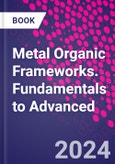Metal Organic Frameworks: Fundamentals to Advanced offers a substantial and complete treatment of published results. The book includes a summary of current research, along with an in- depth explanation of Metal organic frameworks (MOFs) and applications in this versatile area. Metal organic frameworks (MOFs) are structured frameworks made up of metal ions and organic molecules. These materials are similar to sponges and can absorb, retain and remove molecules from their pores. As a result, metal-organic frameworks (MOFs) are the most rapidly evolving substances in chemistry with the highest surface areas due to their well-ordered pore structure.The exciting and vast surface area allows for more chemical reactions and molecule adsorption, hence this new resource provides the newest updates on the topics covered.
Please Note: This is an On Demand product, delivery may take up to 11 working days after payment has been received.
Table of Contents
Part 1: General Inception, synthesis and modification1. Metal organic frameworks (MOFs):Current trends, challenges and future prospects
2. Metal organic frameworks (MOFs) constructed from Biomolecular Building Blocks
3. Natural and synthetic Polymer-Based Metal organic frameworks (MOFs)
4. Metal organic frameworks (MOFs) and their composites with metal ions
5. Paramagnetic metal organic frameworks (MOFs) nanocomposite
6. Alkaline Earth Metal-Based Metal-Organic Frameworks (MOFs)
7. Organosulfonate-Based Metal-Organic Frameworks
8. Lanthanum based metal-organic frameworks (MOFs)
9. Bulk synthesis and Shaping of Metal-Organic Frameworks
10. Platinum Group based Metal-Organic Frameworks (MOFs) nanocomposites
11. Stability of metal organic frameworks (MOFs)
12. Different effective strategies to develop active sites in Metal-Organic Frameworks (MOFs)
13. Metal organic frameworks Linkers: Optical Functionality and Chiral Linker
14. Functional Linkers for Electron-Conducting MOFs and Extended Linkers for Ultrahigh Surface Area Metal-Organic Framework
Part 2: Experimental and Theoretical insights
15. ANN and QSAR approaches towards metal organic frameworks (MOFs)
16. Impact of molecular simulations in the area of metal organic frameworks (MOFs)
17. Computational Screening of MOFs for environmental protection
18. The Gas Adsorption Mechanisms in Metal-Organic Frameworks from Classical Molecular Simulations
19. Metal organic frameworks (MOFs): Computational modeling in catalysis
20. Metal organic frameworks (MOFs): Computational modeling in ionic compound
21. DFT based molecular modelling for MOFs
Part 3: Significance and Importance
22. Metal-Organic Frameworks (MOFs) for Energy Storage Supercapacitor Application
23. Metal-organic frameworks (MOFs) for reasonable carbon dioxide fixation and electrocatalytic carbon dioxide reduction
24. Metal-organic frameworks (MOFs) for Drug delivery
25. Metal-Organic Frameworks (MOFs) for wastewater treatment
26. Metal-Organic Frameworks (MOFs) as an efficient photocatalysts
27. Metal-Organic Frameworks (MOFs) for ion-exchange
28. Emerging role of Metal Organic Frameworks (MOFs) in renewable energy and fuel storage
29. Thermo-mechanical and anti-corrosion characteristics of metal-organic frameworks (MOFs)
30. Metal organic Frameworks (MOFs) and Biomacromolecules for Biomedical Applications
31. Metal organic Frameworks (MOFs) for Biosensing application
32. Metal organic frameworks (MOFs) for gas purification and gas adsorption
33. Role of Metal organic frameworks (MOFs) in organic reactions
34. Metal organic frameworks (MOFs) as an enzyme in catalytic reaction
35. Toxicity of Metal-Organic Frameworks (MOFs) in living system








